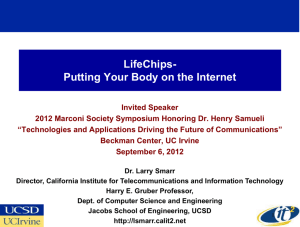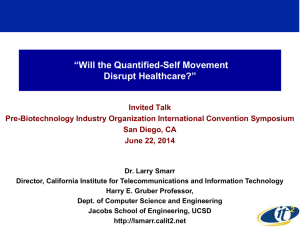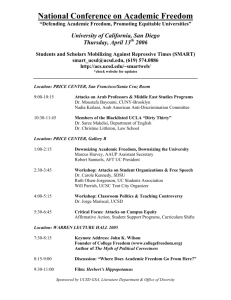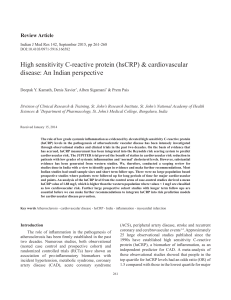PPT - Larry Smarr - California Institute for Telecommunications and
advertisement
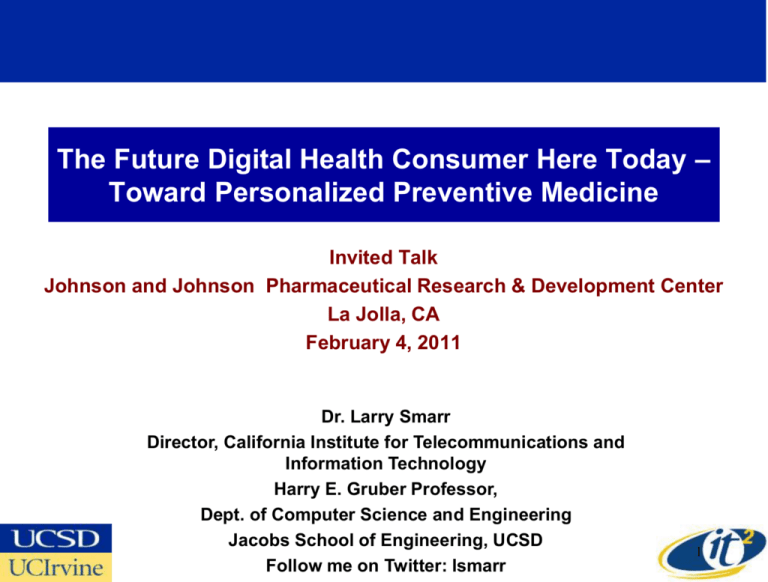
The Future Digital Health Consumer Here Today – Toward Personalized Preventive Medicine Invited Talk Johnson and Johnson Pharmaceutical Research & Development Center La Jolla, CA February 4, 2011 Dr. Larry Smarr Director, California Institute for Telecommunications and Information Technology Harry E. Gruber Professor, Dept. of Computer Science and Engineering Jacobs School of Engineering, UCSD Follow me on Twitter: lsmarr 1 Calit2 Has Been Had a Vision of “the Digital Transformation of Health” for a Decade • Next Step—Putting You On-Line! www.bodymedia.com – Wireless Internet Transmission – Key Metabolic and Physical Variables – Model -- Dozens of Processors and 60 Sensors / Actuators Inside of our Cars • Post-Genomic Individualized Medicine – Combine – Genetic Code – Body Data Flow – Use Powerful AI Data Mining Techniques The Content of This Slide from 2001 Larry Smarr Calit2 Talk on Digitally Enabled Genomic Medicine Nine Years Later I Am Recording My Metabolic Self www.bodymedia.com Elliptical Gardening Up and Down House Steps 25 Week Average: 2473 Calories Burned/Day 1:19 hr Physical Activity/Day (>3 METs) 6887 Steps/Day (~3.4 Miles) Measure Quantity and Quality of Sleep 25 Week Ave: 6:51 hrs with 81% Efficiency Quantifying My Sleep Pattern Using Zeo Surprisingly About Half My Sleep is REM! REM is Normally 20% of Sleep Mine is Between 45-65% of Sleep An Infant Typically Has 50% REM Over the Next Decade an Explosion of Health Sensing: Center for Wireless &Population Health Systems Sensors embedded in the environment Geocoded data on safety, location of recreation, food, hazards, etc Sensor data Psychological & Social sensors + Mood, Social network (peers/family) Clinical & Personal Health Attention, voice analysis Record Data + Ecological data on Biological sensors determinants of health BP, Resp, HR, Blood (e.g. glucose, + electrolytes, pharmacological, Analysis & comparison of hormone), Transdermal, Implants parameters in near-real time (normative and ipsative) + Diet & Physical Activity sensors Physical activity (PAEE, type), sedentary Sufficient population-level Posture/orientation, diet intake (photo/bar data to comprehend trends, code) model them and predict health outcomes Wearable Environmental sensors + Air quality (particulate, ozone, etc) Feedback in near real-time via Temperature, GPS, Sound, Video, SMS, audio, haptic or other Other devices & embedded sensors cues for behavior or change in Rx device = True Preventive Medicine! Center for Wireless and Population Health Systems: Driven by Major Health Challenges for Wireless and Population Systems •Center Research on Systems of Wireless,Health Clinical, & Home Technologies to Measure & Improve Lifestyle & Other Health-Related Behaviors In: – Adolescents – – – – – Healthy & to Prevent Weight Gain Overweight & Obese At Risk for Type 2 Diabetes With Chronic Disease Recovering from Leukemia – Adults – Depression – Schizophrenia – Promoting Successful Aging – Exposure Biology Research – Cancer Comparative Effectiveness Research Kevin Patrick, UCSD SOM, Director Center for Wireless & Population Health Systems: Cross-Disciplinary Collaborating Investigators • UCSD School of Medicine – Kevin Patrick, MD, MS, Greg Norman, PhD, Fred Raab, Jacqueline Kerr, PhD – Jeannie Huang, MD, MPH • UCSD Jacobs School of Engineering – Bill Griswold, PhD, Ingolf Krueger, PhD, Tajana Simunic Rosing, PhD • San Diego Supercomputer Center – Chaitan Baru, PhD • UCSD Department of Political Science http://cwphs.ucsd.edu – James Fowler, PhD • SDSU Departments of Psychology & Exercise/Nutrition Science – James Sallis, PhD, Simon Marshall, PhD • Santech, Inc. – Jennifer Shapiro, PhD, Ram Seshan, MS, MBA • PhD students and Post-doctoral Fellows (current) – Jordan Carlson, Barry Demchak, Laura Pina, Ernesto Ramirez, Celal Zifti 7 Center for Wireless & Population Health Systems: Integrative View to Support Interventions Source: Kevin Patrick, UCSD SOM & Calit2 Environmental/Ecological Factors Interpersonal & Psychosocial Factors Genetic & Biological Factors Medical & Exercise Sciences Behavioral & Social Sciences Environment, Population & Policy Sciences Center for Wireless &Population Health Systems: Developing and Testing Engineering-Based Solutions Source: Kevin Patrick, UCSD SOM & Calit2 Environmental/Ecological Factors Interpersonal & Psychosocial Factors Genetic & Biological Factors NanoTech, Drug Delivery, Sensors, Body Area Networks (BANs) BAN-to-Mobile-toDatabase, SMS/MMS Social networks Ubicomp, Location-Aware Services, Data Mining, Systems Sciences Two Projects in the Calit2 Center for Wireless & Population Health Systems • CitiSense – Sensing of Individual’s Environment • SMART – Use of Social Networks to Change Behavior CitiSense –New NSF Grant for Fine-Grained Environmental Sensing Using Cell Phones Seacoast Sci. 4oz 30 compounds Intel MSP contribute W CitiSense L C/A EPA F distribute S CitiSense Team PI: Bill Griswold Ingolf Krueger Tajana Simunic Rosing Sanjoy Dasgupta Hovav Shacham Kevin Patrick mobile social SMART Social Mobile Approach to Reduce Weight PURPOSE To leverage social networks, social media, mobile phones, and the web for weight loss among 18-35 year old young adults. Funded with a 5-year grant from NHLBI/NIH Source: Kevin Patrick, UCSD SOM & Calit2 mobile social SMART Social Mobile Approaches to Reduce Weight INTERVENTION Facebook an Intact Social Network + Mobile Phone txt Messaging + Smartphone Mobile Apps + Website SMART Study 1 - Participant 2 - Friend of Participant 3 - Friend of Friend Source: Kevin Patrick, UCSD SOM & Calit2 Study Design: 400 Subjects, 18-35 years old male & female, Weight: 25 < BMI < 34.9 University students at four colleges in the San Diego area n = 200 Comparison n = 200 Treatment • Owns a personal computer • Owns a mobile phone and uses text messaging • Facebook user / willing to start using Facebook • RECRUITMENT BEGINS: March 2011 • ENROLLMENT BEGINS: April/May, 2011 Collaborators and platforms: Lifechips--Merging Two Major Industries: Microelectronic Chips & Life Sciences LifeChips: the merging of two major industries, the microelectronic chip industry with the life science industry 65 UCI Faculty LifeChips medical devices I am the Future Digital Health Consumer: Measuring the State of Your Body and “Tuning” It I Arrived from 20 Years in the Midwest in 2000 and Decided to Move Against the Obesity Trend 2010 2000 Age 62 Age 52 www.xconomy.com/san-diego/2010/05/12/how-internet-pioneer-larry-smarr-lost20-pounds-by-becoming-a-quantified-self/ Goal: Lose Weight by Changing What &How Much I Eat, While Increasing Aerobic Exercise Exercise is Elliptical and Walking Losing Diet Discipline Gradually Moving to Zone Diet and Regular Exercise Reached Desired Weight Back on Track, Fewer Calories More Exercise Blood Pressure 134/73 Pulse 55 Resting Pulse Lowered to 45 Goal: Reduce My Body Fat Through Nutrition and Exercise Fat Loss: Chest First, Then Thighs, & Finally Abs Most of Loss in First 3-4 Years, Then Very Slow % Body Fat Drops From 21% TO 15% Higher Body Fat Can Increase the Risk of Heart Disease, Diabetes, and Cancer Measurements by Trainer Terry Martin I Lost More Than 1/3 of My Original Body Fat Goal: Quantify Your Food Intake So You Can “Tune” Your Glucose/Insulin System and Lower Inflammation Computed Average Over 12 Days When at Home for Maximum Accuracy Measure All Food and Drink Components, Then Use USDA Lookup to Compute Each Item • Quality of Food Still Need to Lower Sugar & Increase Protein and Decrease Fat by 15% – All Organic and Mostly Locally Grown – Carbs are Low Glycemic Index – No Added Sugar or Refined Flour – Mostly Fruits and Vegetables – Proteins are Lean – Meat is Grass Fed – No Corn or Antibiotics – Fish is Wild, Often Locally Caught – Fats are Omega-3 Rich – Supplemented by 7g Daily Pharmaceutically Purified Fish Oil Pills Goal: Improve My Omega-3 ScoresTo Reduce Inflammation & Protect Against Future Heart Disease Graphics from www.anne-marie.ca/ratiokits/ If your Omega-3 Score is at least 7.2 and your DHA Score is at least 4.5, you are 32% less likely to develop heart disease If your EPA+DHA Score is at least 4.6, you are 70% less likely of dying from a heart attack. = My Values Tested by yourfuturehealth.com Ref: Based on Lemaitre et al., n-3 Polyunsaturated fatty acids, fatal ischemic heart disease, and nonfatal myocardial infarction in older adults: the Cardiovascular Health Study. Am. J. Clin. Nutr. 77:319-325 (2003). In Spite of My High Levels of Omega-3s, Blood Measurements Show Chronic Inflammation hsCRP from Blood Tests Symptom: Acute Diverticulitis “Come Back When You Have a Symptom” hsCRP Should Be <100 Antibiotics 21 High Sensitivity Complex Reactive Protein is the Standard Blood Test for Inflammation Blood Tests Did Not Reveal Colon Immune Response-Stool Tests Provide Additional Insight hsCRP from Blood Tests Others from Stool Tests by yourfuturehealth.com Symptom: Acute Diverticulitis 30x Normal 25x Normal 15x Normal “Come Back When You Have a Symptom” hsCRP Should Be <100 Lactorferrin Should Be <73 Invisible Episodic Colon Immune Response Antibiotics Future Challenge: Danger of Persistent hsCRP Inflammation and Destabilized Microbiome Goal: Monitor the Colon Microbiome- an Ecological Battle Between Beneficial and Harmful Bacteria All 3+ or 4+ Three Weeks Before Taking Antibiotics Two Years After 10 Days of Antibiotics Levaquin & Metronidaloze These Tests Culture Bacteria Two 0+ Next Step Get DNA Microbe, Parasite, Yeast Test Goal: Determine the Structural State of Each Internal Organ and Major Body Subsystems Stress Test with Echocariogram Heart Fitness Structural Weakness Carotid Ultrasound Imaging Plaque Thickness 64 Slice Heart CT Scan Plaque Sites Valve Anomalies Physical Colonoscopy Detect Polyps Colon Disease 3D Full Body Scan mm Accuracy Small Tumors Organ Damage Plaque Sites Virtual Colonoscopy Amazing Improvements Are Possible Through Nutrition, Exercise, and Stress Management The Quantified Body of Professor Ramesh Rao, UCSD Division Director, Calit2 Mar-08 May-08 Dec-08 Feb-09 Jun-09 July-10 Target LDL 151 103 89 82 86 56 < 130 HDL 42 42 62 59 71 64 ≥ 40 Triglycerides 223 100 57 81 60 53 < 150 0.7 0.6 <1 7.5 < 15 hsCRP 3.4 0.5 Homocysteine 21.5 8.5 Broad Spectrum Amino Acid Vegetarian Diet, 1000 Miles of Running, 1000 Hours of Yoga Should You Keep Your Health Data Private or Share to Gain the Most Knowledge? Where I Believe We are Headed: Predictive, Personalized, Preventive, & Participatory Medicine Quantify ~2500 Blood Proteins, 50 Each from 50 Organs or Cell Types from a Single Drop of Blood To Create a Time Series www.newsweek.com/2009/06/26/a-doctor-s-vision-of-the-future-of-medicine.html You Can Download This Presentation at lsmarr.calit2.net
